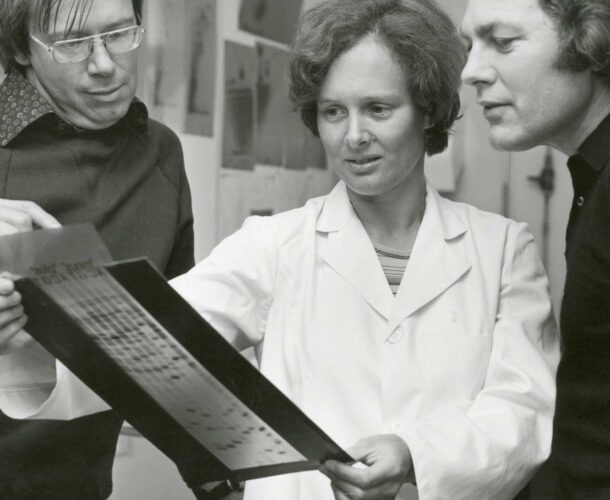From the mid 1970s, molecular biology was at the forefront of efforts to solve the mysteries of the immune system. The recently arrived team of Suzanne Cory and Jerry Adams was spearheading efforts at the institute to use genetic technologies to clarify the molecular intricacies of immune cells. They had already made a worldwide splash with their 1975 discovery that messenger RNA wears a cap. Now their attention was focused on the race to discover how antibodies are made.
Immune mystery
Our immune system is constantly fighting innumerable bacteria, viruses and other pathogens that wage war on our bodies. Antibodies are a key defense. As Gus Nossal discovered at the institute in 1958, each B cell is specialised to make only one type of antibody. Hence, our body must make billions of different B cells, each able to make a different type of antibody. And it does an amazing job.
But how can there be enough genes to encode all the different antibodies the body creates?
In 1976, Tonegawa showed that, unlike all other genes, the genes encoding antibodies occur in our DNA as ‘snippets’ that are randomly assembled in each B cell. The mixing and matching of these snippets in different B cells enables our body to make the myriad different antibodies needed to fight any infection. He would later win the Nobel Prize for this discovery.
Losing it
But an important puzzle remained, namely how are the snippets brought together? Could the gene bits be copied and then randomly joined, or could long RNA molecules be made spanning all the snippets and subsequently spliced in various ways? The answer comes in 1980 when Cory and Adams report in Cell and Nature that each B cell actually deletes many of the intervening antibody gene snippets while randomly assembling the single antibody gene it will use.
They were the first team in the world to show that mammalian cells can change by deleting DNA, rather than just switching genes on or off.
When Cory won the Australia Prize for Science in 1998, she recalled this discovery:
“Immunologists had long known that an organism can make billions of different types of antibodies to defend against infection,” she said. “What they didn’t know was whether there were billions of genes encoding all these antibodies or whether there was a single gene that constantly threw off different forms of itself to produce different antibodies.
“The truth, as we and others discovered, lay somewhere in-between. We found that there are only a few hundred antibody genes, but they are encoded as bits and pieces which can recombine in a myriad ways, thereby creating much greater diversity to fight infection. Most surprisingly, we found that chunks of DNA actually get deleted during this process.”1
Loss of DNA remains a unique feature of the immune system. As well as illuminating the remarkable genetic gymnastics of antibody formation, the insights from this work laid the foundation for the later finding by Adams and Cory that mistakes in the antibody gene assembly process can lead to cancer.


